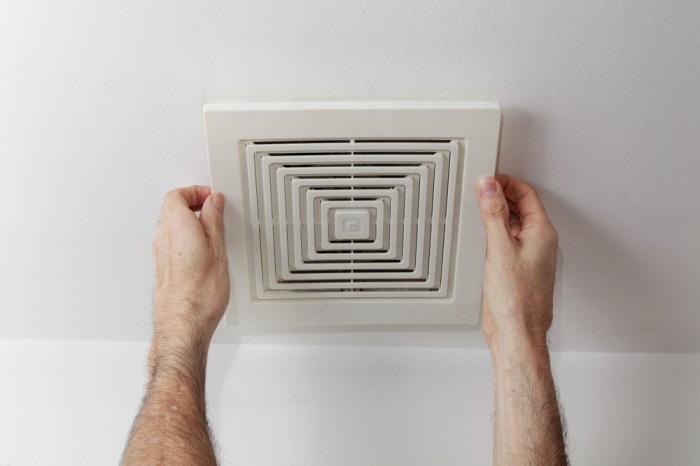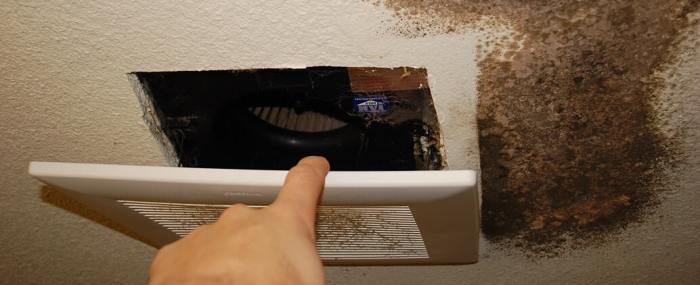Bathrooms are one of the most humid rooms in your home, making them a prime breeding ground for mold. Mold can cause a variety of health problems, including allergies, asthma, and respiratory infections. It can also damage your home’s finishes and fixtures.
One of the best ways to prevent mold growth in your bathroom is to use a bathroom exhaust fan. Exhaust fans help to remove moisture from the air, which makes it less hospitable to mold. In this article, we’ll discuss the importance of using a bathroom exhaust fan, the different types of exhaust fans available, and how to use your exhaust fan effectively.
Importance of Proper Bathroom Exhaust Fan Use
Bathrooms are humid environments that can easily become breeding grounds for mold and mildew if not properly ventilated. Mold can cause a variety of health problems, including respiratory issues, allergies, and asthma. It can also damage your bathroom fixtures and surfaces.
Using a bathroom exhaust fan is the most effective way to prevent mold growth. Exhaust fans remove moisture from the air, which helps to keep the bathroom dry and mold-free.
Crucial Situations for Exhaust Fan Use
- After taking a shower or bath
- When using the bathroom for an extended period of time
- When the bathroom is humid or stuffy
- When there is visible mold or mildew growth
Types of Bathroom Exhaust Fans
Exhaust fans play a vital role in preventing mold and maintaining a healthy bathroom environment. Various types of exhaust fans are available, each with its advantages and disadvantages.
When selecting an exhaust fan for your bathroom, consider the size of the room, the level of moisture produced, and the noise level you’re comfortable with.
Axial Exhaust Fans
- Axial exhaust fans are the most common type, featuring a propeller-like blade that draws air out of the room.
- They are relatively inexpensive and easy to install, making them a popular choice for homeowners.
- However, they can be noisy and less efficient than other types of fans.
Centrifugal Exhaust Fans
- Centrifugal exhaust fans use a spinning impeller to draw air out of the room.
- They are more powerful and efficient than axial fans, but they are also more expensive and require more complex installation.
- They are a good choice for large bathrooms or bathrooms that produce a lot of moisture.
Inline Exhaust Fans
- Inline exhaust fans are mounted in the ductwork of the bathroom, rather than on the ceiling.
- They are very quiet and efficient, but they require professional installation.
- They are a good choice for bathrooms that are located in close proximity to other rooms, as they will not create noise that can be heard in other areas of the house.
Installation and Maintenance of Bathroom Exhaust Fans
Installing and maintaining bathroom exhaust fans is crucial to prevent mold growth and ensure proper ventilation. Here’s a guide to help you with the process.
Before installing a fan, ensure it meets the ventilation requirements for your bathroom size. Typically, a fan with a CFM (cubic feet per minute) rating of 50 CFM per 50 square feet of floor area is recommended.
Installation
- Choose a location for the fan on the ceiling or wall, ensuring it’s centered over the shower or bathtub.
- Cut a hole in the ceiling or wall according to the fan’s dimensions.
- Install the mounting bracket and connect the fan’s electrical wires to the circuit.
- Secure the fan to the mounting bracket and seal any gaps with caulk.
- Connect the exhaust duct to the fan and vent it outside through the roof or wall.
Maintenance
- Clean the fan blades and housing regularly to remove dust and debris.
- Check the exhaust duct for blockages and clean it if necessary.
- Lubricate the fan motor every few months to ensure smooth operation.
- Replace the fan filter every 3-6 months, especially if it’s located in a dusty area.
Effective Use of Bathroom Exhaust Fans
To prevent mold growth effectively, it is crucial to use bathroom exhaust fans correctly. Proper usage involves understanding the optimal time to turn on and off the fan, as well as employing techniques to maximize ventilation and minimize condensation.
Turn the Fan On Before Showering
Activating the exhaust fan 15-30 minutes before taking a shower allows it to remove moisture from the air before the steam from the shower fills the room. This proactive approach helps prevent the accumulation of moisture that can lead to mold formation.
Leave the Fan Running After Showering
After showering, keep the exhaust fan running for at least 30 minutes or until the mirror is no longer fogged. This extended operation ensures the removal of residual moisture that lingers in the air and on surfaces.
Maximize Ventilation
To enhance ventilation, open a window or door in addition to using the exhaust fan. This creates a cross-flow of air that helps circulate and remove moisture more effectively.
Prevent Condensation
To minimize condensation, use a squeegee to wipe down shower walls and surfaces after showering. Additionally, avoid hanging wet towels or clothing in the bathroom, as these can contribute to moisture accumulation.
Additional Mold Prevention Measures
Mold thrives in moist environments, making bathrooms a prime target. To effectively prevent mold growth, it’s crucial to implement additional measures beyond using a bathroom exhaust fan.
Moisture Control
- Limit moisture sources by fixing leaky faucets, showerheads, and pipes.
- Open windows or use a dehumidifier to reduce humidity levels.
- Use mold-resistant paint or sealants on bathroom surfaces.
Proper Cleaning
Regular cleaning is essential for mold prevention. Use mold-killing products on surfaces like shower tiles, grout, and bathroom fixtures.
Regular Inspections
Inspect bathrooms frequently for signs of mold growth, especially in hidden areas like behind shower curtains or under sinks. Address any mold issues promptly to prevent further spread.
Additional Products and Techniques
- Air purifiers with HEPA filters can remove mold spores from the air.
- UV light bulbs can kill mold on surfaces.
- Anti-mold sprays can be applied to bathroom surfaces to inhibit mold growth.
Final Summary
By following the tips in this article, you can help to prevent mold growth in your bathroom and create a healthier, more comfortable environment for your family.



